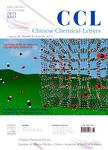Single nanozyme-based colorimetric biosensor for dopamine with enhanced selectivity via reactivity of oxidation intermediates
作者机构:Jiangsu Engineering Laboratory of Smart Carbon-Rich Materials and Devices Jiangsu Province Hi-Tech Key Laboratory for Bio-Medical Research School of Chemistry and Chemical Engineering Medical School Southeast University
出 版 物:《Chinese Chemical Letters》 (中国化学快报(英文版))
年 卷 期:2024年第35卷第10期
页 面:425-429页
核心收录:
学科分类:081704[工学-应用化学] 07[理学] 08[工学] 0817[工学-化学工程与技术] 080202[工学-机械电子工程] 070302[理学-分析化学] 0703[理学-化学] 0802[工学-机械工程]
基 金:supported by the National Natural Science Foundation of China (Nos. 22174014 and 22074015)
主 题:Artificial recognition Colorimetry Dopamine Nanozyme Selectivity
摘 要:Reliable and selective sensing of dopamine(DA) is essential for early diagnosis of mental *** the various potential methods, nanozyme-based sensing systems have demonstrated promising sensitivity and reliability. However, owing to the lack of substrate specificity, it is challenging to selectively detect DA using nanozymes. Herein, based on the reactivity of the DA oxidation intermediates,we report a cascade colorimetric sensing system for the selective detection of DA using only a single nanozyme. It was disclosed that the oxidation product of DA catalyzed by Co-N-doped carbon sheets(Co-N-C, a common oxidase-like nanozyme), dopamine quinone(DAQ), showed significant biocatalytic electron-donating activity in the reduction of O2to generate O2·-. Further using O2·-to oxidize3,3,5,5-tetramethylbenzidine(TMB), a colorimetric sensing platform for DA was constructed with a linear detection range of 50 nmol/L to 50 μmol/L and a low limit of detection of 4 nmol/L. Thanks to the reactivity of the oxidation product, without any biometric units(such as nucleic acids, enzymes,and antibodies/antigens), the reaction selectivity of DA against other interferences(e.g., ascorbic acid,adrenaline, 5-hydroxytryptamine, and glutathione) was enhanced up to 71-fold. Beyond complicated cascade systems requiring at least two nanozymes, sophisticated artificial recognition via multiple interactions was simplified by exploiting the oxidative properties of product intermediates; thus, only a single common oxidase-like nanozyme was needed. This work offers a new strategy to enhance the selectivity of nanozymes for bioanalytical applications.



